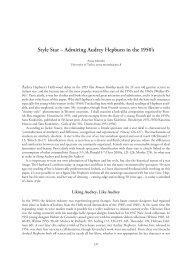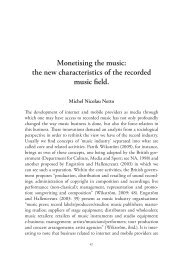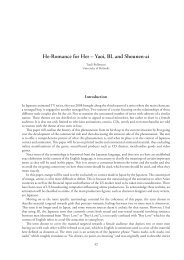Fans, Fawns and Fauns: Ballet Stardom, Dancing Genius and ... - IIPC
Fans, Fawns and Fauns: Ballet Stardom, Dancing Genius and ... - IIPC
Fans, Fawns and Fauns: Ballet Stardom, Dancing Genius and ... - IIPC
Create successful ePaper yourself
Turn your PDF publications into a flip-book with our unique Google optimized e-Paper software.
did not know anything about ballet as an art form. In<br />
image 2, a cartoon from Peterburgskaya gazeta (Christmas<br />
special, 25.12.1912/7.1.1913), Diaghilev is seen<br />
hatching ballerinas in an incubator fuelled by the gas<br />
flame of advertisements. Aside of inflating the reputation<br />
of ballerinas, the Russian critics accused Diaghilev<br />
of catering to his Western audiences a stereotypical<br />
idea of Russia <strong>and</strong> Russians as an Oriental people<br />
stuck in the Middle Ages (see e.g. Teatr i iskusstvo<br />
17./30.5.1909; or Utro Rossii 1./14.8.1910).<br />
Also the Western manner of speaking of Nijinsky<br />
as a genius was ridiculed in Russian papers (e.g.<br />
Teatr i iskusstvo 31.5./13.6.1909), although when the<br />
dancer was dismissed by the Imperial Theatres, critics<br />
immediately took his side <strong>and</strong> dem<strong>and</strong>ed he should<br />
be re-engaged (see e.g. Rech 29.1./11.2.1911; Wiley<br />
1979/1980 for further discussion). Furthermore, Nijinsky’s<br />
modernist choreographies, <strong>and</strong> the Western outrage<br />
that continued to accompany his works in 1913<br />
– Jeux to the music of Debussy, <strong>and</strong> particularly Le<br />
Sacre du Printemps to the music of Stravinsky – simply<br />
proved to Russian critics that Russian art was now truly<br />
in advance of the West. Indeed, what is truly remarkable<br />
about these reviews is, that the Russians across the<br />
political spectrum praise precisely the qualities their<br />
Western colleagues abhorred in these works. 4<br />
This is to point out that Nijinsky’s reputation as<br />
an embodiment of heady sensuality, his “afterlife” in the West, is an Orientalistic discourse. Following Richard<br />
Dyer’s (1991, 17-27) discussion on ‘male-identified’ <strong>and</strong> ‘male-in-betweenist’ homosexual imagery, speculations<br />
as to who Nijinsky “really” was fall into two principal types, both of which conflate Nijinsky with one of his onstage<br />
roles. On one h<strong>and</strong>, there is the <strong>and</strong>rogynous rose-coloured spirit of Spectre, which, indeed, was the image<br />
the reputedly lesbian Romola Nijinsky emphasised (Nijinsky 1980, 112-115, 200, 218). On the other h<strong>and</strong>, there<br />
is the hypersexual Faun, whose body-stocking focused attention on the crotch, <strong>and</strong> who nevertheless did not get<br />
(or want) the girl.<br />
In a way, the undesirable qualities of Nijinsky’s stardom guaranteed he could only be desired by those themselves<br />
seen as undesirable by the dominant discourse – the ballet fans, regardless of their sexual orientation. As<br />
stated, since genius could not be recognised by all, Nijinsky’s continuing popularity amongst the lay public of<br />
dance in the 1920s <strong>and</strong> 1930s practically forced dance experts to refute him. Nijinsky’s fame was turned into<br />
proof that Nijinsky had not been a genius but merely a virtuoso, whose art decayed <strong>and</strong> died with the body of<br />
the dancer, despite what the lay public believed. Simultaneously, Nijinsky’s choreographic work was stamped as<br />
artistic failures presaging his insanity, as attested by the quick disappearance of his four works from the dance repertory<br />
– that is, by exactly the opposite logic of argumentation. By the 1930s, it became a sign of connoisseurship<br />
not to like Nijinsky. The Dance Encyclopaedia, first published in 1949, went as far as to claim that there existed a<br />
‘Nijinsky conspiracy’ keeping the fame of this dancer alive:<br />
so few people, comparatively speaking, ever saw Nijinsky dance, that if his fame were based on his actual appearances<br />
before the public, he would now have been completely forgotten. [- -] Nijinsky’s lasting fame is due mostly to the<br />
legend that has been created around him. This legend has been continually fed by the writings of people connected<br />
with (or disconnected from) the Diaghilev <strong>Ballet</strong>s Russes, who considered it vital or profitable to delve into the most<br />
minute details of Nijinsky’s dancing <strong>and</strong>, more often, Nijinsky’s personal relations with Serge Diaghilev. Also, there<br />
is a group of people on the fringe of ballet which has made Nijinsky its demigod <strong>and</strong> continues to worship at his<br />
shrine. [- -] But his role in the history of ballet <strong>and</strong> his influence on the art of ballet are extremely modest. (Chujoy<br />
& Manchester 1967, 670.)<br />
The illicit discourse thus focuses on making money on the sc<strong>and</strong>alous relationship between Nijinsky <strong>and</strong> Diaghilev,<br />
of whom there is a long eulogy in the same book, focusing, of course, on his professional achievements. The<br />
120







